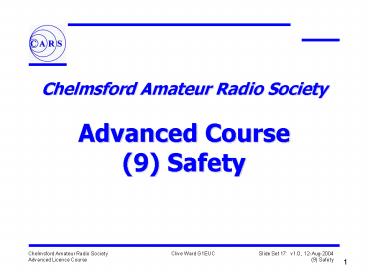Chelmsford Amateur Radio Society Advanced Course (9) Safety - PowerPoint PPT Presentation
1 / 9
Title:
Chelmsford Amateur Radio Society Advanced Course (9) Safety
Description:
Advanced Course (9) Safety High Voltages Anything over 30V can be dangerous! All exposed metal surfaces should be earthed Unless impractical, work should never be ... – PowerPoint PPT presentation
Number of Views:167
Avg rating:3.0/5.0
Title: Chelmsford Amateur Radio Society Advanced Course (9) Safety
1
Chelmsford Amateur Radio Society Advanced
Course(9) Safety
2
High Voltages
- Anything over 30V can be dangerous!
- All exposed metal surfaces should be earthed
- Unless impractical, work should never be carried
out on live equipment - Valve equipment generally uses power supplies
with potentials much higher than domestic mains
voltage - Recommend Residual Current Devices (RCDs) on
mains
3
Portable Operation
- Operating /P can introduce new hazards
- Overhead lines
- Poor electrical supplies
- Trailing cables
- Damp ground
- Excessive field strengths
- So survey first, check cable routes/protection
(trip hazards), use correct fusing, and use
RCDs. - No live working!!!
4
Mobile Operation
- Operating in vehicles and vessels can bring new
hazards - Insecure equipment
- Long flexible aerials
- Accidental shorts to earth
- Distracted driving
- RF induction into vehicle/vessels control
circuits - Secure equipment, check cable routing/protection,
use correct fusing, use hands free equipment, pay
attention to good radio housekeeping
5
RF Field Strengths
- Must comply with National Radiological Protection
Board (NRPB) Investigation Levels for exposure to
RF radiation. - The lowest limit for electric field strength was
50V/m in the 14-146 MHz range - If the Investigation Level is exceeded the cause
must be investigated and reduced to a desirable
one. - Check the latest levels. They are published at
- http//www.nrpb.org/press/information_sheets/amate
ur_radio.htm - Field Strength calculations are covered in the
EMC Section
6
RF Safety Levels
7
Lightning Protection
- Thunderstorms carry heavy static charges!
- The static charge can ionise the air to form a
low resistance path to ground allowing a very
high current to flow as a lightning strike - The resulting risk to life, domestic property and
electronic equipment associated with a strike
and/or build up of a static charge is very high. - Little can be done to protect against a direct
strike. Good static discharge systems can
prevent dangerous static build up on aerial
systems. Disconnecting aerials reduces risk
8
Protective Multiple Earthing
- PME systems are where the mains earth terminal is
connected to the neutral of the electricity
service at the consumers premises, and are
usually identified with a warning label. - All metal pipes and fittings within the premises
are connected to the PME bonding point. - Under severe fault conditions (such as a neutral
break) PME systems have the potential to cause
fatal electric shocks and/or fires in Amateur
Radio Stations. - The RF Earth in an Amateurs station should be
connected to the PME bonding point to maintain
safety under fault conditions in accordance with
the IEE Wiring Regs.
9
Summary
- All exposed metals should be earthed.
- No work on live equipment, be careful with
valves. - Working /P can bring new hazards.
- Mobile working can bring new hazards.
- Compliance with NRPB RF exposure minimum
Investigation Levels is essential. - Thunderstorms can be dangerous, take necessary
precautions - PME Amateur Radio equipment RF earths should be
connected to the PME bonding point.































